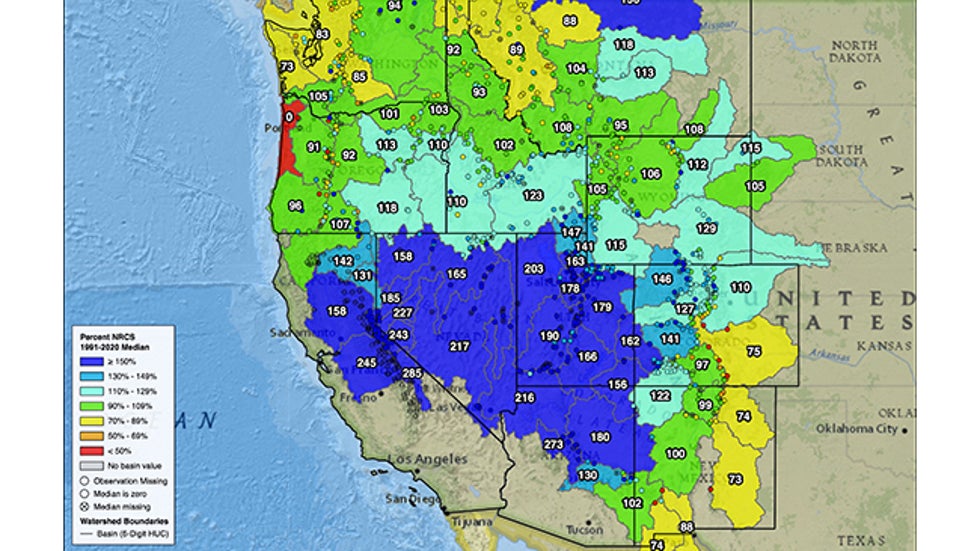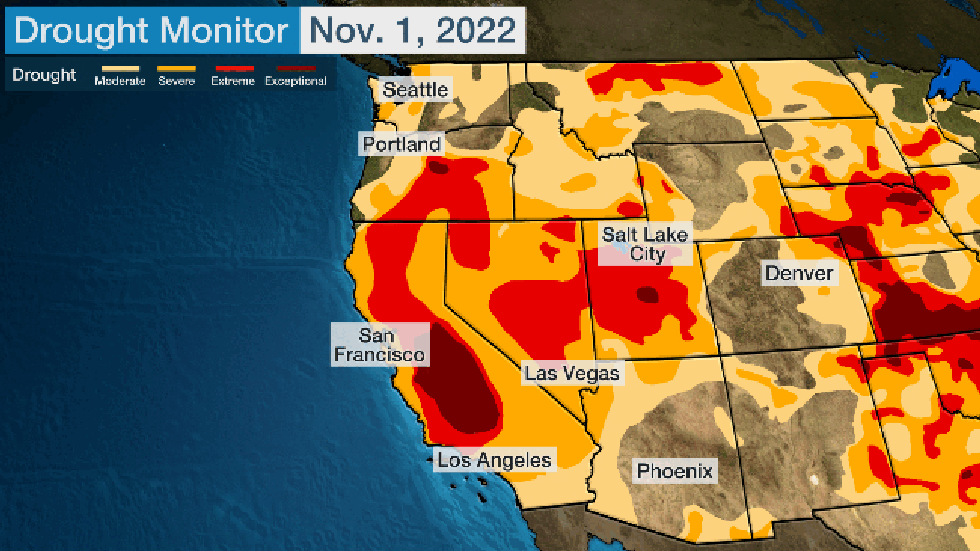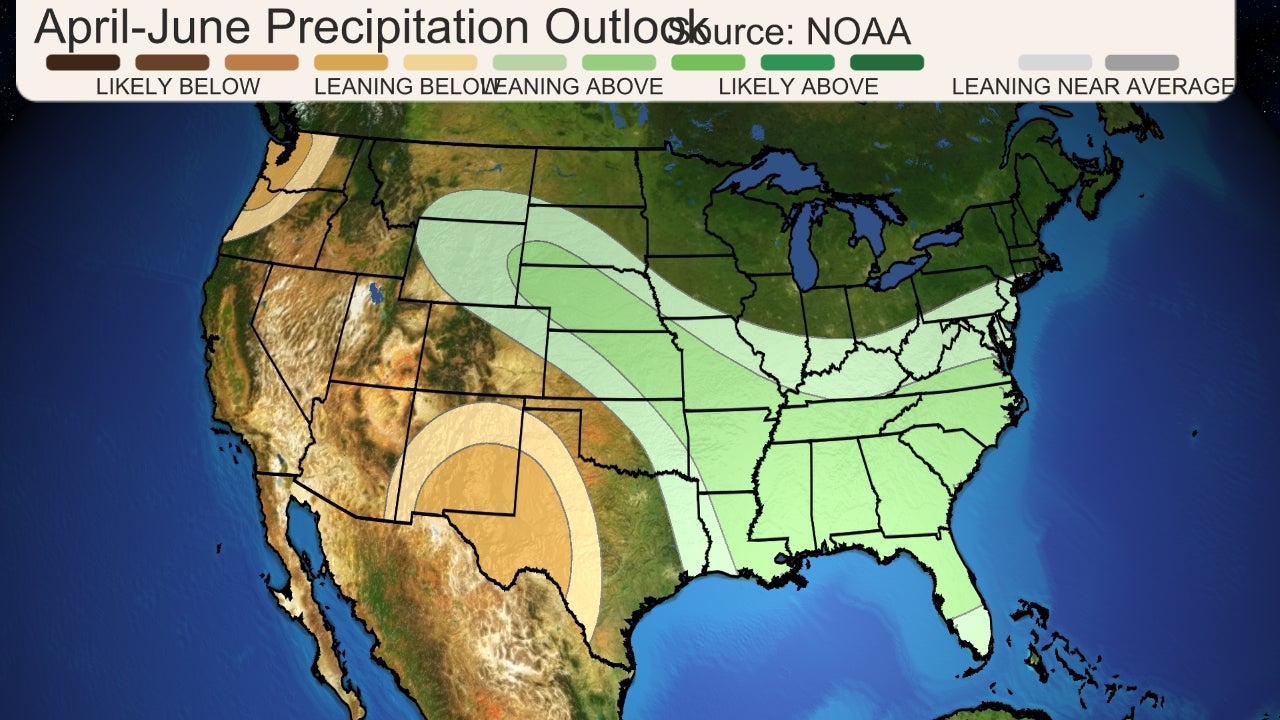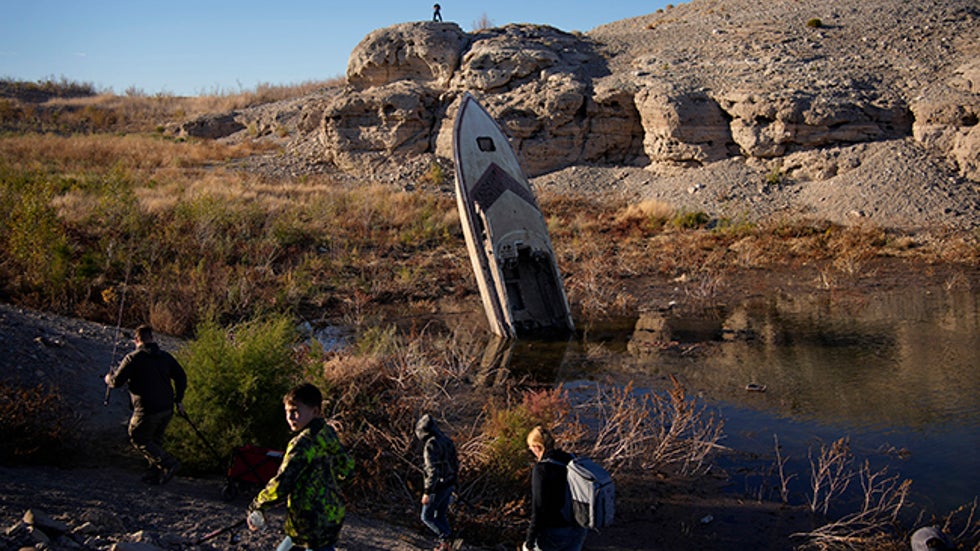Jonathan Erdman
A wetter winter with ample snowpack is a hopeful sign for some drought relief in the West, including California, but it won't make a significant difference for the Colorado River Valley's 20-plus-year long drought.
Let's explore each of the factors water managers in the West are watching closely, beginning with the hopeful signs.
The snowpack is still impressive.
As of Feb. 6, the water content of the snowpack was at least 50 percent above average from Utah and northern Arizona to Nevada and most of California's Sierra, according to data from the National Resources Conservation Service's SNOTEL network.
In some of these areas, the snowpack was at record early-February levels, in records dating as far back as the late 1970s.
 The estimated water content of the western snowpack on Feb. 6, 2023, expressed as a percentage of 1991-2020 average for that time of year. Areas in darkest blue, from Utah and northern Arizona to Northern California, were most above average. A number of 150 means it is 50 percent above the average for Feb. 6.
The estimated water content of the western snowpack on Feb. 6, 2023, expressed as a percentage of 1991-2020 average for that time of year. Areas in darkest blue, from Utah and northern Arizona to Northern California, were most above average. A number of 150 means it is 50 percent above the average for Feb. 6.California's statewide snowpack was a little more than double the early February average, ahead of the record pace from 1982-83, according to the California Department of Water Resources.
It's also impressive in Utah's Wasatch, as the photo below from Alta nicely illustrates.
Other than providing some epic ski conditions, snowpack acts as a "frozen reservoir", storing water which is released when it melts in spring and summer.
Sierra snowpack supplies about 30 percent of California's water, according to the CDWR. This snowmelt feeds into the State Water Project, providing water to 27 million people and 750,000 acres of farmland in California.
A series of nine storms from just after Christmas through mid-January, each with a plume of moisture known as an atmospheric river, dumped up to 20 feet of snow in the Sierra and pushed the snowpack to record levels.
California's reservoirs have risen.
The same three-week parade of storms, while also triggering destructive flooding and landslides, also gave a significant boost to California's reservoirs.
As of early February, the state's major reservoirs for water supply were at least near their typical levels for this time of year, according to the CDWR.
Several reservoirs in the Sierra foothills, including Lake Oroville and Folsom Lake, were above average early-February levels. Lake Oroville was at its highest level in almost three years, a rather sharp turn around from its most recent drought-ridden low in late summer and fall 2021.
There is some drought relief.
The late Dec. through mid-Jan. series of storms dumped almost half a year's worth of precipitation in California, one of the state's wettest three-week stretches on record.
Higher California reservoir levels and increased soil moisture lead to some incremental, short-term improvements in the drought since fall, as you can see in the animation below.
We'll come back to this later. There is much more to drought relief than what has recently happened over the past couple of months.
 Drought Monitor analyses on Nov. 1, 2022, and Jan. 31, 2023. There has been some modest improvement in the western drought due to a recent stretch of wet weather from late Dec. through mid-Jan.
Drought Monitor analyses on Nov. 1, 2022, and Jan. 31, 2023. There has been some modest improvement in the western drought due to a recent stretch of wet weather from late Dec. through mid-Jan.Will it stay wet through spring?
While these are all favorable and hopeful signs, it may be all for naught if the pattern dries out again.
"We know from experience how quickly snowpack can disappear if the dry conditions return in the months ahead," said CDWR director Karla Nemeth said in a press release during the state's snow survey on Feb. 1.
So to what extent the West continues to see snowpack build up through spring is critical for more short-term relief.
According to NOAA's latest precipitation outlook, the best chance of a wet spring is in the northern Rockies. Most of California, Nevada and Utah have a coin-flip chance of a wet spring.
This may lead to some additional short-term drought improvement through April from Northern California to the northern Rockies, according to NOAA's seasonal drought outlook released on Jan. 31.

A much longer road lies ahead.
Even if the rest of this winter and spring are wet, there's a much longer road ahead.
The West is in the midst of a long-term drought since the beginning of the 21st century, believed to be the region's most severe "megadrought" in at least 1,200 years.
This now 23-year long drought has taken its toll on reservoirs. The Great Salt Lake, Lake Mead and Lake Powell have each dropped to record low levels at some point since last summer.
 People walk by a formerly sunken boat standing upright into the air with its stern buried in the mud along the shoreline of Lake Mead at the Lake Mead National Recreation Area, Friday, Jan. 27, 2023, near Boulder City, Nev. More than 10% of the water carried by the Colorado River evaporates, leaks or spills as the 1,450-mile powerhouse river of the West flows through the region’s dams, reservoirs and open-air canals.
People walk by a formerly sunken boat standing upright into the air with its stern buried in the mud along the shoreline of Lake Mead at the Lake Mead National Recreation Area, Friday, Jan. 27, 2023, near Boulder City, Nev. More than 10% of the water carried by the Colorado River evaporates, leaks or spills as the 1,450-mile powerhouse river of the West flows through the region’s dams, reservoirs and open-air canals.So it will take much more than one wet winter and spring to replenish these depleted reservoirs.
"Above-average precipitation over the next 3 to 5 years, combined with water conservation-focused resource management, would be needed to completely alleviate long-term hydrologic drought," wrote NOAA in a Jan. 24 drought status update.
NOAA's update also noted it could take "months or years" for water to filter downward beyond the top layers of soil and replenish deeper aquifers depleted from overuse during the drought.
And this is all playing out as climate change is contributing in the warming and drying of the Southwest U.S., including the Colorado River Basin.
Given the explosion in population in the Southwest, including Southern California, Nevada and Arizona, some don't see reservoir levels recovering.
"To think that these things would ever refill requires some kind of leap of faith that I, for one, don't have," Brad Udall, water and climate scientist at Colorado State University, told the L.A. Times.
The Weather Company’s primary journalistic mission is to report on breaking weather news, the environment and the importance of science to our lives. This story does not necessarily represent the position of our parent company, IBM.
The Weather Company’s primary journalistic mission is to report on breaking weather news, the environment and the importance of science to our lives. This story does not necessarily represent the position of our parent company, IBM.

No comments:
Post a Comment